Food trends in the U.S, Europe and China
Editorial

Since the 1980s, there has been a proliferation in the availability of inexpensive and highly palatable foods, leading to a shift in the overall healthfulness of population diets. Despite decades of global efforts to align dietary behaviours with national and international recommendations, a poor diet remains one of the leading risk factors for ill-health, including dyslipidemia, cardiovascular disease, several types of cancer, and psychological illnesses.
Research endeavors have focused on characterizing dietary trends across the lifespan and globally, as well as investigating associations with disease risk.
- In the viewpoint by Riccardi et al. (2020), authors synthesized a body of evidence, concluding that unfavourable changes in dietary behaviours among Europeans were associated with increased cardiovascular disease risk.
- In the study by Bu et al. (2021), summarized by Costa, a similar shift in dietary patterns and diet-related behaviours was observed among the Chinese population, with an increased preference for consuming both carbohydrate-rich foods, such as fruits and vegetables, and energy-dense foods such as meat, snacks, and beverages.
- Both studies by Liu et al. (2021) and Yu et al. (2021), reported by Chanséaume-Bussiere, examined trends in food sources and diet quality among children and adults between 1999 and 2018 in the United States. It was determined through dietary indices, namely the American Heart Association diet score and/or the Healthy Eating Index 2015, that diet quality of foods (meals, snacks, and beverages) consumed at schools significantly improved, without population disparities. This finding contrasted with observed disparities for food consumed from grocery stores, particularly that poor diet quality decreased in only high-income (vs low-income) households.
Trends that are aligned with a Western style diet high in fat and animal-based foods have been emerging over the past few decades. Collectively, these studies underscore the importance of system level interventions to improve population adherence to dietary guidelines and recommendations and reduce health disparities, which can help to increase healthy life expectancy.
Dr. Maryam Kebbe received her PhD in Medical Sciences from the University of Alberta’s Department of Pediatrics (Edmonton, Alberta) in 2019. She completed postdoctoral training in the Medical Sciences Division at the University of Oxford (Oxford, United Kingdom) and is currently a CIHR Postdoctoral Research Fellow in the Reproductive Endocrinology & Women’s Health Laboratory at the Pennington Biomedical Research Center (Baton Rouge, Louisiana). Dr. Kebbe established her roots as a nutrition and behaviour scientist and innovated solutions within clinical settings to manage obesity, from infancy through adulthood. Drawing in part on her nutrition training, Dr. Kebbe’s niche targets developmental origins of obesity by studying the breastmilk and infant gut microbiomes, with a particular focus on nutritional, immunomodulatory, inflammatory, metabolic, and endocrine mechanisms. Dr. Kebbe hopes to develop and implement novel, effective, and sustainable nutrition and microbiome-based interventions to prevent obesity in infants and children.

